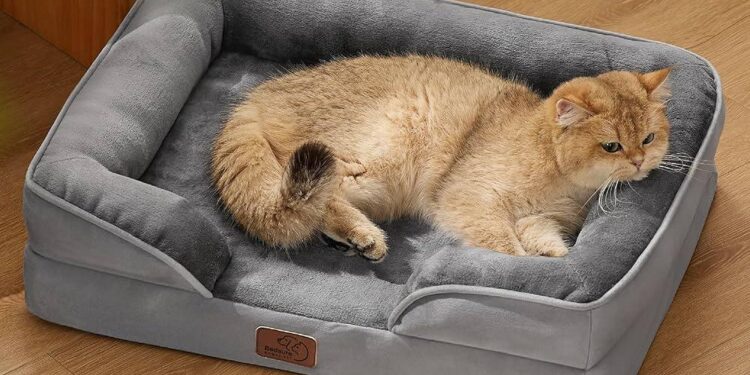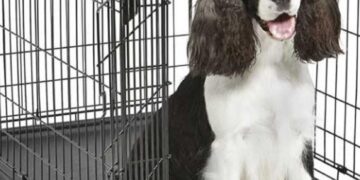Table of Contents
Introduction: The Crate Comfort Conundrum
For many dog owners, the crate represents a sanctuary—a private den where their canine companion can feel safe and secure.
The natural impulse is to furnish this space with soft, comfortable bedding.
Yet, this well-intentioned act often leads to a scene of frustrating devastation: a brand-new bed, meticulously chosen, reduced to a blizzard of shredded fabric and scattered stuffing.
This cycle of destruction is not only a drain on finances, with owners reporting the need to replace beds constantly, but it also carries a grave and potentially lethal risk.
Ingested fabric and stuffing can cause life-threatening intestinal blockages, turning a simple purchase into a veterinary emergency.
This guide serves as a definitive roadmap through the complex landscape of dog crate beds.
It aims to cut through marketing hype, demystify technical specifications, and provide a clear framework for selecting the right bed.
The goal is to empower owners with the knowledge to decode their dog’s specific needs, transforming the crate bed from a recurring expense and a source of anxiety into a sound investment in their dog’s health, safety, and well-being.
Section 1: The Great Debate: To Bed, or Not to Bed?
The foundational question of whether to place bedding in a crate is fraught with conflicting advice.
The decision is not a simple yes-or-no but a nuanced risk assessment that requires careful observation of the individual dog.
The seemingly straightforward rules often clash with the complexities of canine behavior and the practical realities of crate training.
The Veterinarian’s Cautionary Principle
From a medical and safety standpoint, the argument against bedding is stark and compelling.
Veterinary professionals and trainers frequently advise against putting any bedding in a crate, particularly for puppies and adolescent dogs.
The primary reason is the significant danger of chewing and ingestion.
A dog left unsupervised can easily tear apart a bed and swallow the pieces, leading to a gastrointestinal obstruction that requires emergency surgery.
Many vets recommend waiting until a dog is fully mature—often over a year old—and has demonstrated consistent, non-destructive behavior in the crate before introducing any soft bedding.
This safety-first approach establishes a baseline of medical caution.
The Real-World Counterpoint
Despite this clear warning, a vast body of anecdotal evidence from dog owners presents a powerful counter-narrative.
Many report that a bare plastic or metal crate tray was a non-starter for their dogs.
Puppies, in particular, would cry incessantly, refuse to settle, or show clear signs of stress and discomfort in an empty crate.
For some, adding a bed proved to be the “miracle” that resolved nighttime whining and fostered a positive association with the crate.
In one owner’s experience, providing a washable bed—even though it meant using a crate technically “too big” for the puppy—eliminated all nighttime problems and encouraged the dog to enter the crate willingly.
This highlights a fundamental conflict: for some dogs, the psychological stress of a bare crate may present its own set of welfare concerns, while the comfort of a bed is the key to successful crate training.
The decision to use a bed is therefore not just about the dog’s propensity to chew; it is an equation where the owner must weigh the risks against the potential benefits for their specific animal.
The “no bed” rule is a low-risk default strategy.
The “bed” approach is a higher-risk, potentially higher-reward strategy that demands more active management, including careful supervision, selection of appropriate starter bedding, and the readiness to remove it if destructive habits emerge.
Deconstructing the “Why”: The Case for Bedding
Beyond the initial training phase, there are compelling health and behavioral reasons to provide crate bedding.
- Comfort and Denning Instinct: Dogs are naturally den animals and are predisposed to seek out comfortable, enclosed spaces for rest. A well-chosen bed helps transform the crate from a mere enclosure into a desirable sanctuary, reinforcing the idea that it is a safe space for relaxation, not a place of punishment.
- Health and Joint Support: For many dogs, a hard surface is not just uncomfortable—it’s detrimental to their physical health. This is especially true for senior dogs, large and giant breeds prone to joint disease, and dogs recovering from surgery. Lying on hard floors can cause pressure sores, also known as calluses or hygromas, to form on bony points like elbows and hips. These sores can become painful and even infected. Providing proper orthopedic support is a critical preventative measure against the progression of conditions like arthritis and hip dysplasia.
- Temperature Regulation: While some dogs, particularly double-coated breeds, run hot and actively seek out cool floors, others require insulation. In colder climates, or for dogs recovering from medical procedures, a bed provides essential warmth and helps prevent drafts.
A Framework for Decision-Making
To move from confusion to an informed choice, owners can assess their dog’s readiness for a bed based on several key factors:
- Age and Maturity: Puppies, especially those under a year old, are in their peak chewing phase and represent the highest risk group. Adult dogs with a proven track record of not being destructive are generally safe candidates. Senior dogs have unique needs, often requiring orthopedic support and potentially waterproof bedding due to age-related incontinence.
- Chewing History: It is crucial to honestly assess the dog’s chewing intensity. A “power chewer” who systematically destroys toys and household items requires a far more durable solution than a “gentle mouther” or a dog that doesn’t chew bedding at all.
- Potty Training Status: A dog that is still having frequent accidents will quickly soil bedding, creating a difficult-to-manage hygiene issue. While dogs have a natural instinct not to soil their sleeping area, this can break down if they are crated for too long or if the crate is too large, allowing them to use one end as a toilet and the other for sleeping.
- Anxiety vs. Boredom: Destructive chewing in a crate often stems from underlying issues like separation anxiety or a lack of stimulation. It is vital to address these root causes through adequate physical exercise, mental enrichment, and behavior modification. A bed will not solve these problems and will likely become the target of the dog’s frustration.
Section 2: The Anatomy of a Resilient Crate Bed: A Materials Deep Dive
The modern dog bed market has evolved significantly, with top-tier products now resembling high-performance technical gear rather than simple cushions.
This shift reflects a growing consumer demand for durability, safety, and health-conscious design, mirroring trends in the human outdoor equipment and wellness industries.
Understanding the materials and construction of these advanced beds is key to making a wise investment.
The Fortress of Fabric: Decoding “Chew-Proof” and “Indestructible”
The terms “chew-proof” and “indestructible” are a source of considerable skepticism among dog owners, many of whom have seen these claims fail within hours.
True durability lies not in marketing language but in material science.
- Material Science 101: The toughest beds utilize “superhero fabrics” borrowed from military and industrial applications.
- Ballistic Nylon/Canvas: This is a thick, synthetic fabric characterized by a very tight, dense weave. Originally developed for flak jackets to protect against shrapnel, its structure makes it highly resistant to the tearing and abrasion caused by a dog’s teeth and claws. Brands like K9 Ballistics and Gorilla Dog Beds build their reputations on using this material.
- Ripstop Fabric: This material incorporates a grid of thicker, reinforcing threads woven at regular intervals. This crosshatch pattern acts as a tear-stopper; if a puncture does occur, the rip is contained within one of the small squares, preventing catastrophic failure.
- PVC/Vinyl: Often used for elevated cot-style beds (like Kuranda) or heavy-duty mats (like Primo Pads), PVC-coated fabrics are durable, completely non-absorbent, and easy to wipe clean. This makes them an excellent choice for outdoor use, kennels, and situations where hygiene is paramount.
- The Science of Tear Resistance: A fabric’s ability to resist tearing is a function of its tensile strength, its elongation (how much it can stretch before breaking), and its packing density (the tightness of the weave). While a looser weave can sometimes distribute tearing forces, it is more vulnerable to punctures from a dog’s canine teeth. The dense, tightly packed structure of ballistic nylon provides superior resistance to both punctures and subsequent tearing.
The Foundation of Health: Orthopedic Foam and Joint Support
An orthopedic bed is not a luxury reserved for senior dogs; it is a vital piece of health equipment.
It serves as a preventative measure for large and giant breeds genetically predisposed to joint issues, a necessary support for thin breeds lacking natural padding, and a crucial aid for any dog recovering from surgery or injury.
- Decoding the Foam:
- The Gold Standard: High-Density Memory Foam: True orthopedic support comes from high-density, solid memory foam that contours to the dog’s body, evenly distributing weight and relieving pressure on joints. A simple test for quality is to press down firmly on the bed; if the foam compresses to the point where the floor can be felt, it lacks sufficient density and will not provide adequate support. Premium brands like Big Barker and Bully Beds use multiple layers of thick, human-mattress-grade foam to ensure their beds do not “bottom out” under the weight of even a giant breed dog.
- The Impostor: Egg-Crate Foam: While often marketed as “orthopedic,” low-quality, convoluted (egg-crate) foam provides very little genuine support. It compresses easily and deteriorates quickly, leaving the dog effectively lying on the hard floor.
- The Seal of Safety: CertiPUR-US® Certification: This independent certification is a critical indicator of a safe, high-quality product. It guarantees that the foam has been manufactured without harmful substances like formaldehyde, mercury, lead, regulated phthalates, or carcinogenic flame retardants. It also certifies low emissions of Volatile Organic Compounds (VOCs), contributing to healthier indoor air quality. This addresses a key concern for owners who demand the same non-toxic standards for their pets as they do for themselves.
The Practicality Principle: Mastering Washability, Waterproofing, and Hygiene
A dog bed that cannot be easily and thoroughly cleaned will inevitably harbor dirt, dander, allergens, and odor-causing bacteria, creating an unsanitary environment.
True washability exists on a spectrum.
- Level 1: Machine-Washable Cover: This is the minimum standard for any quality dog bed. A durable, removable cover that can be machine-washed is essential for routine cleaning.
- Level 2: Waterproof Liner: This is a crucial feature for protecting the bed’s core. An internal waterproof liner sits between the outer cover and the foam mattress, preventing accidents, vomit, or other liquids from soaking into the foam. This is the only way to prevent the growth of mold, mildew, and the development of permanent, deep-set odors.
- Level 3: Fully Washable Core: Representing the pinnacle of hygiene, some brands have engineered foam cores that are themselves fully washable. The Snoozer Forgiveness line, for example, features a mattress that can be completely cleaned with soap and water, allowing for the total elimination of dust mites, allergens, and contaminants from the core of the bed. This is a revolutionary feature for dogs with severe allergies or incontinence.
The Blueprint for Durability: Design, Construction, and Safety
The most durable fabric and foam are useless if the bed’s overall design is flawed.
Key construction details are often what separate a bed that lasts for years from one that fails in weeks.
- Hidden/Protected Zippers: Zippers are a primary target for curious chewers. High-quality, chew-resistant beds conceal their zippers under protective fabric flaps or use industrial-strength Velcro closures to eliminate the temptation entirely.
- Reinforced Seams: Seams are the second-most-common point of failure. Look for brands that advertise triple-stitched or otherwise reinforced seams, which prevent a dog from ripping the bed apart at its edges.
- The Elevated Cot Advantage: The design of cot-style beds like those from Kuranda is uniquely effective against chewing. The fabric is secured within a special channel inside the frame, leaving no exposed edges for a dog to bite and pull. This makes it one of the most genuinely chew-proof designs on the market.
- Non-Slip Base: A non-slip bottom is a practical safety feature that prevents the bed from sliding on hardwood or tile floors, providing stability for the dog, especially for seniors or those with mobility issues.
- Anchor Points: Some crate pads, notably from K9 Ballistics, feature loops or tie-downs at the corners. These allow the owner to secure the pad directly to the crate pan, preventing the dog from flipping, bunching, or dragging the bed, which are often precursors to destruction.
Section 3: The Crate Bed Matrix: Curated Recommendations for Every Canine Persona
Choosing the right crate bed is not about finding a single “best” product, but about matching the right features to a specific dog’s behavior, age, and health needs.
By categorizing dogs into distinct “personas,” owners can more easily identify the solution that will bring them and their dog the most success.
For the Power Chewer & Determined Destroyer (“The Demolition Crew”)
This dog treats every soft object as a challenge to be conquered.
They are often young, high-energy dogs or those who channel anxiety into destruction.
For this owner, extreme durability is the only feature that matters.
- The Elevated Fortress: Kuranda Beds: This is the top recommendation for the most aggressive and persistent chewers. Kuranda’s patented design secures the fabric inside the frame, leaving no edges accessible to teeth. The aluminum frame model is rated for dogs up to 250 pounds and is considered the “best” for durability, while the PVC model is suitable for dogs up to 100 pounds. Testimonials from animal shelters and owners of “crazy chewers” confirm their ability to withstand abuse where all other beds have failed.
- The Armored Pad: K9 Ballistics Chew Proof Armored™ Crate Bed: For owners who prefer a pad to a cot, this is the maximum-security option. It features a padded mattress protected by an aluminum frame that covers all the edges, combining the comfort of a pad with extreme chew resistance.
- The Ballistic Barrier: Gorilla Dog Beds Tough Orthopedic Crate Pad: This pad is constructed from military-grade ballistic material with triple-stitched seams and an exceptionally strong hidden zipper. The company backs its Gorilla Ballistic line with a 125-day chew-proof warranty, offering one free replacement cover if a dog manages to damage it. Owner reviews frequently note that it has succeeded where cheaper “chew-proof” beds from other retailers have been quickly destroyed.
- Honorable Mention: Primo Pads: These heavy-duty vinyl pads are a durable, easy-to-clean, and sanitary option often recommended as a significant upgrade from towels or blankets for determined chewers and for use in kennel environments.
| Product | Type | Key Materials | Chew-Proof Warranty | Primary Benefit | Ideal Use Case |
| Kuranda Aluminum Bed | Elevated Cot | Anodized Aluminum Frame, Heavy-Duty Vinyl or Ballistic Fabric | 1-Year Warranty on all parts | Patented design with no exposed fabric edges makes it virtually impossible to start chewing. | Extreme, persistent chewers; dogs needing maximum airflow; kennels; outdoor use. |
| K9 Ballistics Armored Crate Bed | Armored Pad | Aluminum Frame, Ripstop Ballistic Fabric, CertiPUR-US Foam Core | 120-Day Chew-Proof Promise (store credit if destroyed) | Combines the comfort of a pad with the security of a metal frame protecting all edges. | Heavy chewers who need a padded surface; escape-artist dogs in crates. |
| Gorilla Ballistic Crate Pad | Ballistic Pad | Military-Grade Ballistic Fabric, High-Density Orthopedic Foam | 125-Day Chew-Proof Warranty (one-time free cover replacement) | Extremely durable fabric and reinforced construction resist tearing and abrasion. | Heavy chewers and diggers; large breeds needing a tough but supportive pad. |
For the Senior Sage & Dogs with Aching Joints (“The Comfort Seekers”)
This category includes older dogs, large and giant breeds, and any dog suffering from arthritis, hip dysplasia, or recovering from surgery.
For these dogs, true orthopedic support is non-negotiable for maintaining quality of life.
- The Clinical Gold Standard: Big Barker Beds: Big Barker has established itself as a leader in therapeutic support for large dogs. Its reputation is backed by a clinical study from the University of Pennsylvania, which found the bed significantly reduced pain and stiffness while improving mobility in large dogs with arthritis. The bed’s construction features 7 inches of triple-layer, American-made, CertiPUR-US certified foam and is backed by a 10-year warranty guaranteeing it will not flatten. While not all models are designed for crates, their quality sets the industry benchmark for orthopedic support. It is worth noting that some recent customer concerns have been raised about a potential shift in manufacturing origin, which warrants due diligence from prospective buyers.
- The Durable Support: K9 Ballistics Tough Ripstop™ Orthopedic Crate Bed: This product successfully merges durability with therapeutic support. It features a solid CertiPUR-US certified orthopedic foam core protected by a tough, ripstop ballistic cover. This makes it the ideal choice for a large or senior dog that needs excellent joint support but may still engage in nesting behaviors like scratching or digging.
- The Heavy-Duty Comfort: Bully Beds Orthopedic & Chew-Proof Crate Pads: Bully Beds is another top contender focused on large dogs, offering beds with thick, human-mattress-grade orthopedic foam backed by an impressive 20-year warranty. Their crate pad is thoughtfully designed with a strong Velcro closure instead of a zipper, removing a common chew target and potential hazard.
For the Hot-Natured Hound & Warm Climates (“The Coolers”)
This group includes double-coated breeds like Huskies and German Shepherds, dogs living in hot climates, and any dog that consistently chooses a cool tile floor over a plush bed.
- Elevated Cots (Kuranda, Coolaroo, K9 Ballistics): This is the most effective cooling design. By lifting the dog completely off the ground, these beds allow for 360-degree air circulation, which actively dissipates body heat. The porous mesh fabric further enhances airflow.
- Gel-Infused Mats (The Green Pet Shop, Arf Pets): These mats use a pressure-activated, non-toxic cooling gel that absorbs and draws away body heat without needing electricity or refrigeration. They are highly portable and excellent for adding a cooling layer inside a crate. However, because the gel can be toxic if ingested, they are not suitable for dogs with a history of chewing.
- Specialized Cooling Fabric Mats (EveryYay Cool Orthopedic Crate Mat): These modern mats use advanced textiles that feel cool to the touch. They are often paired with a breathable, egg-crate foam base to provide both a cooling sensation and orthopedic support, making them a good all-in-one solution for crates.
For the Puppy-in-Training & Accident-Prone Pup (“The Trainees”)
This persona includes young puppies who are not yet reliably potty-trained and senior dogs dealing with incontinence.
For these owners, hygiene and absolute washability are the most critical features.
- The Veterinary Standard: Vet Bedding/Fleece: This is the material used by veterinary professionals for post-operative recovery and in whelping boxes. It consists of a thick, plush polyester pile designed to wick moisture away from the surface, keeping the dog dry even if an accident occurs. The entire piece is machine washable and dries quickly, making it exceptionally hygienic.
- The Ultimate in Clean: Snoozer Forgiveness Crate Pad: This product offers the ultimate solution for hygiene. Unlike beds with only a washable cover, the Snoozer Forgiveness features a patented foam core that is entirely washable with soap and water. This allows for the complete elimination of odors, allergens, and bacteria from the very core of the bed, making it the premium choice for dogs with incontinence or severe allergies.
- The Simple & Safe: Old Towels: Acknowledged as a practical, budget-friendly starting point, old towels are a common choice for puppy crates. They contain no stuffing that can be ingested, can be easily washed in hot water to sanitize them, and are readily available. They serve as excellent “test” bedding to gauge a puppy’s chewing habits before investing in a more expensive product.
Section 4: Beyond the Bed: Architecting the Ultimate Crate Sanctuary
The perfect crate bed is a critical component, but it is only one piece of the puzzle.
Creating a true sanctuary that a dog loves requires a holistic approach that addresses the crate environment and the root causes of destructive behavior.
The Foundation: Crate Sizing and Type
The physical crate sets the stage.
The golden rule of sizing is that the crate should be just large enough for the dog to comfortably stand up, turn around, and lie down with legs outstretched.
A crate that is too large can encourage a dog to designate one end as a “potty corner” while sleeping in the other, undermining house training efforts.
For growing puppies, using a crate with a divider is an effective way to adjust the usable space as they grow, ensuring the size is always appropriate.
The Root of the Problem: Exercise and Enrichment
It cannot be overstated: much of the destructive behavior seen in crated dogs, including the shredding of bedding, stems directly from boredom, pent-up energy, or separation anxiety.
A dog that is physically tired and mentally stimulated is far less likely to seek inappropriate outlets for its energy.
Providing a long walk, a vigorous run, or an intense session of fetch or training immediately before crating can dramatically reduce the impulse to chew.
A tired dog is a calm dog, and a calm dog is less likely to destroy its bed.
Making the Crate a Happy Place
The crate must be consistently associated with positive experiences to become a cherished den rather than a dreaded jail.
- Positive Association: Owners should work to build a strong positive association by feeding the dog all its meals inside the crate and providing high-value treats and toys that are available only when the dog is in its crate.
- Safe Chew Toys: Providing a safe and appropriate outlet for the natural chewing instinct is paramount. Durable toys like a classic Kong—which can be stuffed with food and frozen to provide a long-lasting challenge—or a properly sized Nylabone can keep a dog happily occupied and redirect its chewing drive away from the bedding.
The Final Touches: Creating a Den Atmosphere
Simple environmental modifications can enhance the den-like feel of the crate.
Covering the top and sides with a sheet or a fitted crate cover can create a cozier, more secure atmosphere, reducing visual stimuli and promoting relaxation.
Care must be taken to ensure adequate ventilation and to use a cover that cannot be pulled through the bars of the crate and chewed.
Conclusion: An Investment in Restful, Resilient Well-Being
The journey to finding the perfect crate bed begins with a simple question—”to bed, or not to bed?”—and unfolds into a detailed exploration of material science, canine health, and behavioral psychology.
The path leads the owner from the initial dilemma through an understanding of high-performance fabrics, the critical importance of orthopedic support, and finally to a curated matrix of solutions tailored to their dog’s unique persona.
Ultimately, selecting the right crate bed is far more than a simple consumer purchase.
It is a long-term investment in a dog’s holistic well-being.
It is an investment in their physical health, providing the joint support necessary to prevent pain and preserve mobility.
It is an investment in their safety, choosing durable, well-constructed materials to prevent the life-threatening risk of ingestion.
And it is an investment in their mental well-being, helping to create a secure, comfortable den that serves as a true sanctuary.
By cracking the “Crate Bed Code,” an owner makes a foundational choice that supports years of restful nights and resilient health for their most loyal companion.






